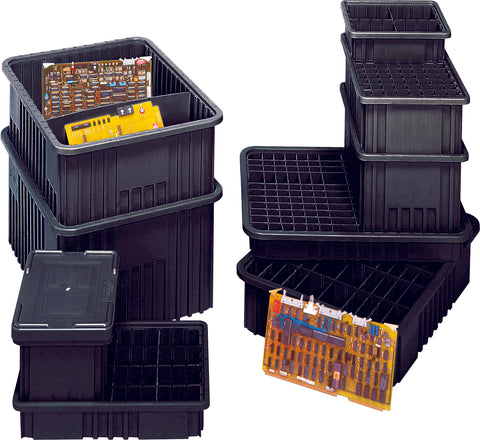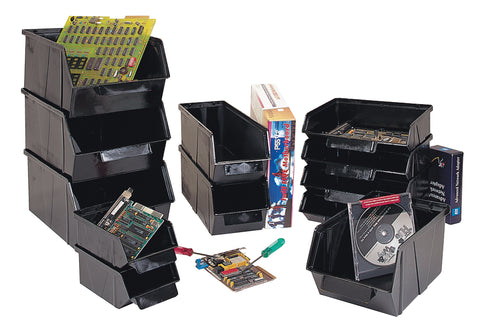The Importance of ESD Bins in Electronic Manufacturing
PCB and electronic component manufacturers have unique requirements when it comes to storing their spare parts and components. These components are often highly sensitive to electrostatic discharge (ESD), which can damage or destroy them. As a result, manufacturers need to use ESD-safe storage solutions to protect their products.
Types of Materials Stored
PCB and electronic component manufacturers store a wide variety of materials in ESD-safe storage solutions. Some of the most common types of materials include:
PCBs: PCBs are the foundation of electronic devices, and they are typically made of a thin layer of laminated copper on a fiberglass or FR4 substrate. PCBs are

very sensitive to ESD damage, which can cause short circuits or open circuits.
Integrated circuits (ICs): ICs are small semiconductor chips that contain millions or even billions of transistors. ICs are very sensitive to ESD damage, which can cause them to malfunction or fail completely.
Transistors: Transistors are semiconductor devices that can amplify or switch electronic signals. Transistors are sensitive to ESD damage, which can cause them to short out or open up.
Capacitors: Capacitors are electronic components that store electrical energy. Capacitors are sensitive to ESD damage, which can cause them to overvoltage and fail.
Resistors: Resistors are electronic components that resist the flow of electrical current. Resistors are less sensitive to ESD damage than other components, but they can still be damaged by high-voltage ESD discharges.
Inductors: Inductors are electronic components that store energy in a magnetic field. Inductors are less sensitive to ESD damage than other components, but they can still be damaged by high-voltage ESD discharges.
Connectors: Connectors are used to connect electrical circuits together. Connectors can be sensitive to ESD damage, which can cause them to corrode or fail.
Crystals: Crystals are electronic components that generate precise frequencies. Crystals are sensitive to ESD damage, which can cause them to crack or fail.
LEDs: LEDs are light-emitting diodes that produce light when an electrical current is passed through them. LEDs are sensitive to ESD damage, which can cause them to fail or produce less light.
Displays: Displays are electronic devices that show images or text. Displays can be sensitive to ESD damage, which can cause them to malfunction or fail completely.
Batteries: Batteries are electronic devices that store electrical energy. Batteries are less sensitive to ESD damage than other components, but they can still be damaged by high-voltage ESD discharges.
Sensors: Sensors are electronic devices that detect changes in the environment. Sensors can be sensitive to ESD damage, which can cause them to malfunction or fail completely.
Real Life Use Case: One of the PCB manufacturer's that we support stores its PCBs in ESD-safe bins. The bins help organize while dissipating static electricity. The bins are also stacked on ESD-safe shelving, which protects the PCBs from impact and other environmental hazards. The shelving becomes ESD-safe by grounding it to the floor with a drag cable.
Environments We've Placed ESD-Safe Storage Solutions in
ESD-safe storage solutions are used in a variety of environments in the PCB and electronic component manufacturing industries. Some of the most common environments include:
Data Centers: Data centers are complex and sensitive environments. They contain a large amount of expensive and delicate electronic equipment. This equipment is susceptible to damage from a variety of sources, including electrostatic discharge (ESD).
Assembly lines: Assembly lines are where PCB and electronic components are assembled into finished products. Assembly lines are typically fast-paced and chaotic environments, which can increase the risk of ESD damage.
Test areas: Test areas are where PCB and electronic components are tested to ensure that they are functioning properly. Test areas are typically clean and controlled environments, but they can still be susceptible to ESD damage.
Shipping and receiving docks: Shipping and receiving docks are where PCB and electronic components are received from suppliers and shipped to customers. Shipping and receiving docks are often busy and chaotic environments, which can increase the risk of ESD damage.
Warehouses: Warehouses are where PCB and electronic components are stored until they are needed in production or shipping. Warehouses can be large and open spaces, which can make it difficult to control static electricity.
Cleanrooms: Cleanrooms are controlled environments with low levels of dust, moisture, and other contaminants. Cleanrooms are used for assembling and testing sensitive electronic components, such as those used in medical devices and aerospace applications.
Benefits of ESD-Safe Storage
ESD-safe storage offers a number of benefits for PCB and electronic component manufacturers, including:
Reduced product damage: ESD-safe storage solutions can help to reduce ESD damage to products, which can save manufacturers money and improve their bottom line.
Improved product quality: By protecting components from ESD damage, ESD-safe storage solutions can help to improve product quality and reduce the number of defective products.

Increased manufacturing efficiency: ESD-safe storage solutions can help to improve manufacturing efficiency by reducing the time it takes to assemble and test products.
Reduced costs: By reducing product damage and improving product quality, ESD-safe storage solutions can help to reduce costs for manufacturers.
Compliance with industry standards: Many industries have standards in place that require manufacturers to use ESD-safe storage solutions for their products.
Real-Life Use-Cases We've Worked On:
A PCB manufacturer uses ESD-safe trays to store its PCBs during the assembly process. The trays help to protect the PCBs from ESD damage and other environmental hazards, such as dust and moisture. This helps to improve the quality of the finished products and reduce the number of defective PCBs.
An electronics manufacturer uses ESD-safe containers to ship its finished products to customers. The containers protect the products from ESD damage and other environmental hazards during shipping. This helps to ensure that the products arrive at their destination in good condition.
A medical device manufacturer uses ESD-safe shelving to store its finished products in its warehouse. The shelving is grounded to protect the products from ESD damage. The warehouse is also equipped with ESD-safe flooring and workbenches to further reduce the risk of ESD damage. This helps to ensure that the medical devices are safe and effective for patients.
Read our other blog posts that discuss ESD-Safe Storage Solutions for Electronic Components:
- ESD Safe Bins & Containers for Data Centers
- PCB Storage in Electronics Manufacturing
- ESD-Safe Storage Solutions for Tech Giants
- Optimizing Electronic Component Storage in the AI era
Ready to Buy?
Take advantage of our decades of experience working with PCB and Electronics manufacturers to place the proper ESD-Safe storage solutions to secure their products.

